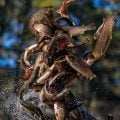How to Tie a Balanced Pine Squirrel Streamer
Producer: Tim Flagler
This is the balanced version of one of my favorite flies, the Pine Squirrel Streamer. Balanced flies have weight out in front of the hook eye and, if properly tied, will hang in a very life-like horizontal orientation when fished. This can sometimes make the difference between a take and a refusal, particularly in still water.
For a hook, I’m going to use a Mustad 90 Degree Jig hook in size 4. Begin by getting the hook firmly secured in the jaws of your tying vise.
For thread, I’ve loaded a bobbin with a spool of UTC 140 Denier in black. Get the thread started on the hook shank behind the 90 degree bend and take a dozen or so wraps rearward before snipping off the tag.
To extend the weight past the hook eye, I’m going to use a small wire tie. You can find them in a variety of colors to blend in or match the color of pine squirrel you’re using. There’s nothing special or heavy-duty about this type of wire tie and they’re readily available in big box stores. For this dark brown Pine Squirrel Streamer, I’m going to go with a black wire tie. Select a single tie and properly feed the strip end into the locking end, then draw the formed loop down, but don’t close it all the way. You need to leave enough room to insert one of the dumbbell eyes, here, extra-small, black nickel Presentation eyes, which are 5/32” in diameter. Feed one of the eyes into the loop of the wire tie then close the loop down all the way. Give the tie a good pull to ensure the loop is fully closed.
Lay the wire tie on top of the hook shank with the eyes pointing down. For this set-up, you want a full hook-eye length of flat wire tie in front of the hook to make the fly balance correctly. Mark the location on the wire tie directly above the hook point. Using a pair of wire cutters, snip the tie off there. Although not essential, I like to trim the snipped end to a point then use a lighter to kind of round the sharp edges off, which have a nasty habit of fraying and cutting tying thread.
Place the wire tie back on top of the hook shank, just as you did before and start taking tight wraps of tying thread to secure it. After you have it anchored fairly well, flip the hook over so you have easier access to the underside of the shank. An ample amount of super glue, here Fly Tyer’s Z-Ment, applied to the thread wraps works wonders in terms of keeping the wire tie from spinning around the hook shank. Continue taking thread wraps over top of the area to further lock things in place. You can then flip the hook back to the orientation in which you started. Again, keep taking thread wraps, this time down the hook shank and over the point of the wire tie. Continue taking wraps all the way back to the start of the hook bend.
You really can use any color of zonked pine squirrel you like for this pattern. Here, I’m using just plain brown. The strips on the outside edges of the skin are generally shorter than those towards the middle, so choose one of the longer middle strips at least until you get more comfortable with the tying procedure. Snip the strip from the skin so it’s as long as possible then hold the strip with the fur canted rearward to the back of the fly. Measure the hide to a hook shank in length then use a little moisture to part the fur at that location. Lay the strip, hide side up, with the part right at your tying thread. Take two or three nice tight wraps to anchor the hide to the top of the hook shank, then pull the strip back and take two wraps around just the shank. Pull the strip forward and take two more wraps around the strip and the shank. This sequence will help to prevent the strip from rotating around the hook shank.
Now, pull the strip back once again and advance your tying thread forward in open spiral wraps, going around the hook eye and out under the locking portion of the wire tie. End with your thread immediately behind the dumbbell eyes. Get hold of the pine squirrel strip and start taking wraps with it up the hook shank so bare hide contacts the shank. The wraps should be just touching. It also helps to preen the fur rearward as you go. Continue taking wraps with the strip in front of the hook eye and then over top of the locking portion of the wire tie. When you reach the back edge of the dumbbell eyes, part the fur and take tight wraps of tying thread to anchor the hide there. You can then lift the strip up and snip the excess off as close as possible. This can be a little tricky to do without cutting your tying thread and most often you need to go back and do a bit more trimming. Continue taking tight thread wraps to absolutely lock the pine squirrel strip down. Then reach for your whip finish tool and use it to do a 4 or 5 turn whip finish, seat the knot well and snip your tying thread free.
If you have any bits of strip or wonky tufts of fur, now’s a good time to trim them off close. Once you have everything cleaned up pretty well, I recommend applying a liberal coating of either head cement or UV cure resin to the thread wraps behind the dumbbell eyes. This will not only make the fly more durable it will also make it more visually appealing.
Yes, you can achieve the same balanced effect using a pin and a heavy bead rather than the wire tie and dumbbell eyes. Both methods have pluses and minuses. Before you tie too many of these, it’s a good idea to attach some tippet to the hook eye on one just to make sure it balances correctly. You’re getting sleepy, very sleepy . . . now hit the like button then subscribe to this channel.
How to Tie "The Insult"
How to Tie a Barr's Emerger BWO











